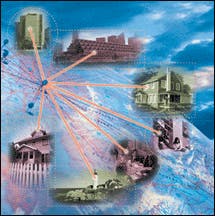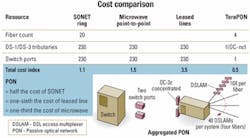Using existing infrastructure, PON can expand revenues
SHRI BALACHANDRAN, Terawave Communications
In the current economic climate, plans to upgrade or replace existing networks are being shelved. Smart companies will take advantage of this lull to overhaul their networks, so when the economy heats up, they will be best positioned to exploit emerging service demands. There is unanimity among industry players-from carriers to legislative authorities-that the next telecommunications explosion will happen in the broadband access space.
To successfully emerge from the downturn, network operators need a solution that efficiently serves existing services and migrates to a new revenue base from those existing services. Most important, to unseat the current mode of operation and justify switching to a new architecture, the new solution must be cost-disruptive. A carrier-driven standards solution is required so that, once deployed, the carrier won't be left stranded with proprietary equipment. Broadband passive optical networking (BPON) may be the most cost-effective solution.
The most common mistake when analyzing the economics of a solution is to compare only the cost of raw equipment. Local-exchange-carrier network planning experts will say the cost of the equipment is only 25% of the total cost of building and running a network. About one-third of the entire cost is spent in operational support that includes day-to-day service management, managing customer churn, network maintenance, operational support-system integration, and personnel training. Another one-third is spent on outside plant concerns such as trenching, securing right-of-way, laying fiber, powering outside nodes, maintaining the loops, troubleshooting, and truck rolls. In addition, there are costs associated with central-office (CO) rack space, node powering, cooling, and other miscellaneous overheads. Instead of the traditional concern for what's less expense, network architects should consider if it is cheaper, better, faster, and smarter than the current mode of operation.
As we navigate through the economics of the access space, it will be recognized that the beauty of BPON is not limited to its installation cost efficiencies. The real clincher lies in the architecture of BPON and the manner in which it handles customer churn and enables a near-maintenance-free outside plant and its ease in supporting legacy and emerging services. BPON (based on the ITU-T G.983 standards) is a fiber-optic access solution that uses totally passive components in the outside system plant.
In simple terms, "better" translates to "doing more with less." There are many advantages to BPON architecture.
More customers with shorter fiber. BPON is a point-to-multipoint fiber-lean architecture. Instead of running a separate strand of fiber from the CO to every customer (like point-to-point Gigabit Ethernet), BPON uses a single strand of fiber to serve up to 32 subscribers. Compare that to an access SONET ring that requires two to four fibers for each lateral split to a single customer location. The higher the fiber count in the minor routes, the higher the fiber count required in the distribution and feeder networks.
Skeptics will be quick to point out that fiber is only 3 cents per foot-practically free. A detailed study based on a city the size of New York reveals that a SONET access fiber plant requires 20 million additional fiber-mi than a BPON access plant, which translates into an extra $6 million in capital savings. A comparable point-to-point architecture such as Ethernet would require 50 million additional fiber-mi-an extra $15 million-in the access plant in contrast to a BPON solution. Fiber cost is typically one of the least analyzed expenses in the access plant.
More services using fewer overlays. A traditional enterprise requires TDM circuits for voice traffic, IP connectivity for data services, and leased lines for enterprise private data. Many enterprises require additional ATM or frame relay links for guaranteed services. A few obscure ones require separate links for video transport. Developing an access architecture for these diverse needs requires anywhere from three to four separate overlay networks-one each for voice, data, and video. IP folks tend to answer this problem by claiming bandwidth is free. They believe if you throw bandwidth at the problem, quality-of-service (QoS) issues will disappear. However, live network analysis suggests that to guarantee 1 Mbit/sec of error-free traffic, an IP network must allocate around 6 Mbits/sec of bandwidth. For this scenario, a point-to-point Ethernet solution translates to 76 Mbits/sec of loading on the metro network-or 66 Mbits/sec for voice, video, and leased-line traffic and 10 Mbits/sec for Internet access.
By comparison, a BPON network consumes about 24 Mbits/sec of metro bandwidth. Turning on advanced features such as dynamic bandwidth allocation (DBA) reduces this bandwidth to 15.7 Mbits/sec of metro-network loading. That is a bandwidth savings of five times over Ethernet and seven times over an equivalent SONET solution.
Eliminating separate overlay networks saves not only on equipment cost, but also management, operations, inventory, training, spares, and maintenance cost. Furthermore, the reduction in demand for metro bandwidth significantly impacts the dimensioning and implicitly the cost of the metro and core networks.
More reliability without power. Anecdotal evidence suggests that the cost of powering the active outside loop easily runs into the millions. With BPON, the outside plant is passive. Eliminating the need for outside plant powering eases deployment and increases reliability. It also saves on power charges, battery maintenance, and frequent field maintenance of repeaters, rectifiers, amplifiers, and other electronic components. In addition, active components usually have much lower meantime between failures compared to passive components, which also translates to reduced truck rolls and maintenance.
Wider service options using less equipment. Although equipment cost is only 25% of the overall network cost, an access solution that provides a low first-install cost will provide rapid payback. On the enterprise side, the Ethernet switch is typically connected to an IP router that feeds into a channel service unit/digital service unit (CSU/DSU) and finally to a SONET customer-located multiplexer.
A BPON optical-network terminal (ONT) could connect directly to the Ethernet switch, reducing the need for a separate CSU/DSU or IP router in some instances. On the CO side, the SONET headend add/drop multiplexer (ADM) equipment connects into M310 digital access crossconnect system (DACS) and ATM switches. The built-in M310 function in the BPON optical line terminal (OLT) and distributed ATM switch functionality in the BPON reduce the need for separate DACSs and edge ATM switches in the CO. All these savings reduce network complexity and total access network cost, which increases network reliability and reduces management costs.
Running a cheaper access network can be achieved by reducing operating costs and efficiently managing customer churn. SONET networks need detailed planning and significant customer pull for futureproof deployment. Adding a new customer on a ring requires additional planning, service downtimes, and many hours of outside plant activity such as splicing and testing.
A major advantage of BPON is its strategic flexibility in rollout. BPON can be deployed in increments of one customer at a time in a non-service-affecting manner. BPON's ability to exploit opportunity clusters and incremental builds provides tremendous relief in capital and quick payback. Handling customer churn, service, bandwidth needs, and service-level-agreement needs is an advantage that a BPON solution provides over any equivalent access solution.
The BPON OLT supports voice, video, and data traffic as well as provides advanced data switching, grooming, and aggregation functions. In effect, it is an edge multiservice switch. While a point-to-point SONET or Ethernet solution consumes a metro switch port for each customer, the OLT aggregates the traffic, using about one-10th the number of ports (see Figure).A smarter access solution meets the base functionality yet exploits the statistical nature of the emerging data-centric network services. SONET's architecture has a protection scheme that consists of two rings: one fiber is used for carrying traffic, while the other serves as a backup when the first fiber fails. At any time, only 50% of the SONET fiber capacity is used.
BPON supports protected and unprotected modes of operation simultaneously on the same (or different) fiber strand. It achieves the same sub-50-msec protection as SONET.
Additionally, it supports service interface protection and SONET-style 1+1/1:1 and 1:N network interface protection. SONET provisions point-to-point circuits between ring nodes. Each circuit is allocated a fixed amount of bandwidth that is wasted when not used-a disadvantage for data traffic, which is inherently bursty. An OC-3 (155-Mbit/sec) SONET network carries a maximum of 84 customers, seeking 400-kbit/sec data service.
A Full Services Access Network (FSAN)-based BPON supports up to 288 similar customers. At least one BPON solution also provides the ability to dynamically reassign bandwidth among users. That improves the BPON usage up to 12 times. Therefore, the same 288 customers can be supported on the network with as low as 9.6 Mbits/sec (or 8%) of bandwidth. The remaining bandwidth can be used for other revenue-generating voice, TDM, and video traffic. For an Internet access application, BPON's ability to do statistical multiplexing with DBA provides 140 times improvement in the bandwidth usage over SONET. Additionally, DBA eliminates unnecessary switch ports and extra network build-outs.
As the access race heats up, the winner will be the operator that delivers services faster than the competition. With its ability to provide remote in-band service provisioning; remote troubleshooting; non-service-affecting customer add and delete; lambda overlay for analog video and high-speed point-to-point links; and integrated voice, data, and video delivery over a single fiber infrastructure, BPON enables near-real-time service provisioning. With faster service provisioning comes faster service turn-up and revenue in-flow.
When comparing access solutions, it's necessary to compare lifecycle costs. The lifecycle cost of maintaining the outside plant, managing service churns, eliminating CO and enterprise middleware gears, and reducing fiber counts and multiple overlays makes BPON a superior long-run access solution.
Shri Balachandran is the senior product-line manager at Terawave Communications (Hayward, CA) and can be reach via the company's Website, www.terawave.com.


